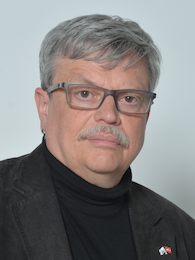Go to
Alex Dommann
Position statement:
Interactions between electronics and mechanics
More than Moore points also in to the direction of MEMS. A critical gap in the pipeline from academic innovation to industrial products is the lack of reliable characterization techniques for such devices. Microfabrication of single crystal silicon allows using its unique combination of electronics with high material quality, low density, high Young’s Modulus, resistance to fatigue and batch processing with low fabrication tolerances in a wide range of geometries and electro-mechanical applications. However, the quality of the crystal in a finished MEMS device is influenced by the fabrication and packaging processes, many of which introduce defects that deteriorate the mechanical stability of the material. Due to the brittle nature of silicon these defects can lead to catastrophic failure during assembly, packaging and operation. To overcome this gap we need to combine the area of material science (synthesis, characterization and processing), metrology and modeling and sometimes also life science and medicine.
By characterization of the failure modes and failure distributions, micromechanical tests support the qualification and optimization of fabrication and die separation processes, allowing improvment in the yield and reliability of systems. Because it is prohibitively complex and time-consuming to test all possible geometries used in MEMS devices it is preferable to use test specimens to predict the failure distribution of structures with arbitrary shapes. Moreover, this allows benchmarking new technologies and processes against existing fabrication methods.
About the panel member:
 Alex Dommann is heading the Department « Materials meet Life » at Empa (Swiss Federal Laboratories for Materials Science and Technology) since summer 2013. He also created an X-Ray center at Empa offering research and services using different X-Ray techniques. Before he was CTO of the CSEM, Centre Suisse d’Electronique et de Microtechnique S.A. Neuchâtel and he was also heading together with Nico de Rooji the Microsystems Technology division at CSEM. He received his PhD in Solid State Physics in 1988 from ETHZ in Switzerland.
Alex Dommann is heading the Department « Materials meet Life » at Empa (Swiss Federal Laboratories for Materials Science and Technology) since summer 2013. He also created an X-Ray center at Empa offering research and services using different X-Ray techniques. Before he was CTO of the CSEM, Centre Suisse d’Electronique et de Microtechnique S.A. Neuchâtel and he was also heading together with Nico de Rooji the Microsystems Technology division at CSEM. He received his PhD in Solid State Physics in 1988 from ETHZ in Switzerland.
His research concentrates on the surface analysis, bio surface interactions, structuring, coating and characterization of thin films and MEMS structures. He is member of different national and international committees and teaches MEMS technology and Crystallography at different Swiss universities and has published more than 100 papers in the fields of thin films, MEMS, reliability and material characterization. He is member of the Swiss Academy of Engineering Science (SATW)
Secondary navigation
- EPFL Workshop on Logic Synthesis and Emerging Technologies
- Luca Amaru
- Luca Benini
- Giovanni De Micheli
- Srini Devadas
- Antun Domic
- Rolf Drechsler
- Pierre-Emmanuel Gaillardon
- Jie-Hong Roland Jiang
- Akash Kumar
- Shahar Kvatinsky
- Yusuf Leblebici
- Shin-ichi Minato
- Alan Mishchenko
- Vijaykrishnan Narayanan
- Ian O'Connor
- Andre Inacio Reis
- Martin Roetteler
- Julien Ryckaert
- Mathias Soeken
- Christof Teuscher
- Zhiru Zhang
- Symposium on Emerging Trends in Computing
- Layout synthesis: A golden DA topic
- EPFL Workshop on Logic Synthesis & Verification
- Luca Amaru
- Luca Benini
- Robert Brayton
- Maciej Ciesielski
- Valentina Ciriani
- Jovanka Ciric-Vujkovic
- Jason Cong
- Jordi Cortadella
- Giovanni De Micheli
- Antun Domic
- Rolf Drechsler
- Henri Fraisse
- Paolo Ienne
- Viktor Kuncak
- Enrico Macii
- Igor Markov
- Steven M. Nowick
- Tsutomu Sasao
- Alena Simalatsar
- Leon Stok
- Dirk Stroobandt
- Tiziano Villa
- Symposium on Emerging Trends in Electronics
- Raul Camposano
- Anantha Chandrakasan
- Jo De Boeck
- Gerhard Fettweis
- Steve Furber
- Philippe Magarshack
- Takayasu Sakurai
- Alberto Sangiovanni-Vincentelli
- Ken Shepard
- VENUE
- Panel on Circuits in Emerging Nanotechnologies
- Panel on Emerging Methods of Computing
- Panel on The Role of Universities in the Emerging ICT World
- Panel on Design Challenges Ahead
- Panel on Alternative Use of Silicon
- Nano-Bio Technologies for Lab-on-Chip
- Functionality-Enhanced Devices Workshop
- More Moore: Designing Ultra-Complex System-on-Chips
- Design Technologies for a New Era
- Nanotechnology for Health
- Secure Systems Design
- Surface Treatments and Biochip Sensors
- Security/Privacy of IMDs
- Nanosystem Design and Variability
- Past Events Archive
